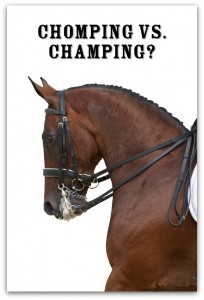It’s a common phrase that’s often said incorrectly. What’s the difference between “champing at the bit” and “chomping at the bit”? Which one is correct?
It’s champing at the bit, not chomping at the bit.
This phrase (or idiom) comes from the sport of kings: horse racing. A bit is part of the apparatus that goes in the horse’s mouth and connects to the bridle and reins so the horse can be controlled and directed by the jockey on its back. The bit fits into a toothless ridge of the horse’s mouth, so the horse never really bites the bit. But it can grind his teeth or jaw against the bit, and if it does, it means that the horse is either nervous, or really excited about racing. That’s how the phrase “champing at the bit” entered everyday communications: to indicate extreme eagerness.
But “chomping” has come to replace “champing” in this phrase. It makes sense, to a degree, because “chomping” is a far more common word than “champing,” and would seem to relate back to the phrase’s origin, because horses’ mouths have teeth, and teeth “chomp.” However, champing is a similar word with a similar meaning to chomp—it means “to grind teeth.” The original phrase works.
In the end, it’s just wrong to say “chomping,” because “chomping” is a transitive verb, or a verb that needs an object for it to make sense. In other words, you have to have something to chomp on if you want to use “chomp.” A horse doesn’t chomp, or bite, the bit—he champs, or grinds, his teeth. No bit is necessary for a champing to happen, so champing is an intransitive verb, which means no “object” is required.
For more brain-twisting facts made simple, check out Engineering Made Simple. It’s available now from Portable Press.








